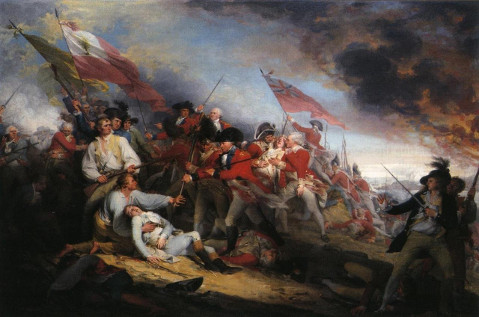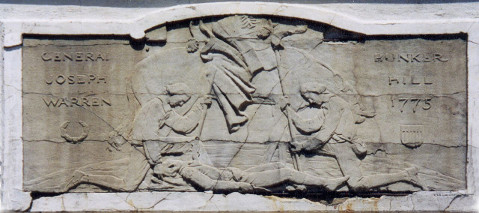Battle of Bunker Hill Depicted
Franceschi House Medallion Recalls Battle's General Warren

On June 17, 1775, the Battle of Bunker Hill was waged between British colonial forces and the Continental Army for control of Boston Harbor. The outcome was a costly victory for the British with over one-third of their force wounded or killed. Inflicting such casualties on the world’s elite army was a great encouragement to the relatively ragtag Continental Army. It caused the British to be more cautious in subsequent battles and to enlist foreign mercenaries to fight the rebels.
Joseph Warren was a physician and colleague of Paul Revere, John Hancock, and Samuel Adams, all now considered founders of the eventual new nation. Warren was the president of the Massachusetts Provincial Congress when he ordered Revere and William Dawes on their “midnight rides” to warn rebels of the advancing British Army. Just days before the Bunker Hill battle, he had been commissioned a Major General in the Continental Army but chose to fight in a soldier’s role rather than as commander. When their ammunition was exhausted, the rebel soldiers fought in retreat, during which Warren was killed.
Warren’s last fictional moments were immortalized in John Trumbull’s painting, “The Death of General Warren at the Battle of Bunker Hill” 50 years after the event. It is a noble — if perhaps inaccurate — depiction of Warren’s death, which was brought about by a musket ball to the head. The painting currently hangs in Boston’s Museum of Fine Arts.
How did a version of the Trumbull painting become a concrete medallion on Santa Barbara’s Franceschi House? All the medallions on Franceschi House were commissioned and installed by Alden Freeman in 1927 during a whirlwind remodel of the house in preparation for its donation to the city. Freeman was the wealthy son of the Standard Oil Trust’s founding treasurer. He bought the house from Dr. Francesco Franceschi’s son with the idea to transform it and the surrounding garden acreage into Franceschi Memorial Park. The plan included modifying the house façade from its original redwood shiplap siding to stucco resembling a Mediterranean villa in honor of Franceschi’s roots. The exterior is adorned with 85 plaster or concrete medallions with a tremendous array of subjects. Some have to do with Franceschi’s heritage and work, but most relate to Freeman’s own interests.
Alden Freeman was a Mayflower descendent and avid genealogist. He was a member of several hereditary societies based on his relation to John Alden (through his mother) and the family branches through the Colonial, Revolutionary and Civil War periods. Many of the medallions on Franceschi House (called Montarioso Medallions) commemorate Freeman relatives but also events and persons of historical significance and contemporary heroes of the 1920s. Freeman fancied himself a historian, particularly in the service of rebellious causes. There are 15 medallions related to the American Revolution alone.
Two medallions relate to Joseph Warren. One is a rendering of the Warren coat of arms, but the other is based on Trumbull’s painting of Warren’s death. The second medallion is large — approximately 68 inches wide and 34 inches high — mounted about 10 feet above the ground and looking out to the Santa Barbara Channel. Time and exposure have taken their toll with obvious cracks and exposed reinforcing metal showing, but the image is there.

Warren lies with a mortal wound to the head, a sword at his side. Fellow soldiers at his head and feet surround him. One holds an upright musket and the other the staff of a Flag of New England as flown during the battle. Behind them is a riderless horse, honoring a fallen army officer. To the left of the image is the name, General Joseph Warren and a wreath. To the right are the words, Bunker Hill 1775, and an American striped shield.
While Alden Freeman was in the process of donating Franceschi Memorial Park to Santa Barbara, he was building another home in Miami Beach. “Casa Casuarina” was completed in 1930 and contains duplicates of the Montarioso Medallions plus many more. All the Miami Beach medallions were mounted in an interior courtyard protected from the elements. In addition when Gianni Versace purchased the building in 1992, he restored the medallions to their original condition. In what is now known as the Versace Mansion, a copy of our Bunker Hill medallion is in complete and perfect condition. Luckily all the rest of the medallions mounted on Franceschi House have restored models in Miami Beach to aid their own rehabilitation, courtesy of Gianni Versace.



